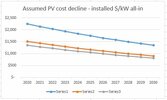smorgasbord
Active Member
We all expect to have Tesla Energy somehow disrupt energy generation/storage, but as you said, Tesla hasn't been executing well there. Why hasn't Buffalo become a giga-solar-roof factory, at least in terms of how many it produces? As for Powerwalls, is there really a shortage of suitable cells? They don't have to be small in size and light in weight. Cycle life would seem to be the primary consideration. It's been half a decade since TeslaThanks for the insights.
What are your thoughts on Energy Generation and Storage as the second disruptive business? . . . basically turning the Utility industry upside down.
My 5 year plan does not have Tesla disrupting the Utility industry (my growth here is modest). This is due to my uncertainty on battery supply and Tesla's less than stellar track record in growing the Energy business.
Tesla's current valuation is very future-looking. If you try to value it based on automotive alone, you have to go out more years than Mr. Market ever looks. If you try to value Tesla on new disruptive businesses, well those are hard to predict and certainly the timing is hard to predict. Tesla's EV disruption was actually, in my view, an outlier in that it was reasonably obvious even back in 2012/2013 that it was going to happen. Now FSD/robotaxis or Solar Roof/utility break-up are both much harder to anticipate. Anyway, comparing the current pre-second-disruption Tesla to a very (10 year) post-second-disruption Amazon doesn't feel right to me.




